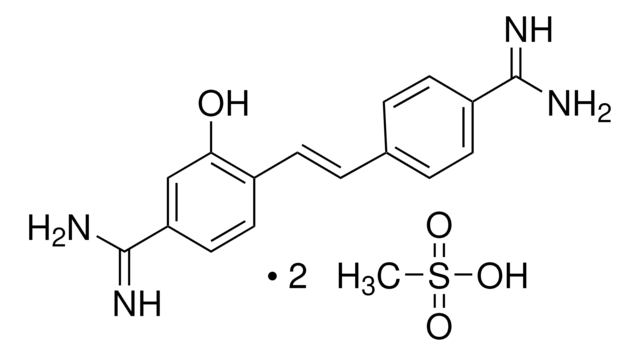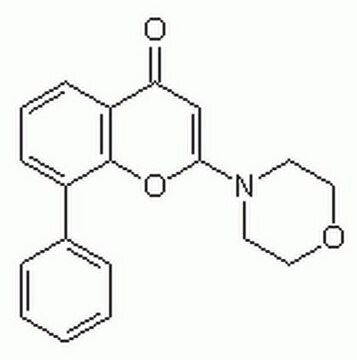AG325
Fluoro-Jade® C
Se connecterpour consulter vos tarifs contractuels et ceux de votre entreprise/organisme
About This Item
Code UNSPSC :
12352200
eCl@ss :
32160405
Nomenclature NACRES :
NA.41
Produits recommandés
Forme
powder
Poids mol.
Mw 823 Da
Fabricant/nom de marque
Chemicon®
Fluoro-Jade®
Technique(s)
immunohistochemistry: suitable
Fluorescence
λex 485 nm; λem 525 nm
Conditions d'expédition
ambient
Description générale
Fluoro-Jade C, like its predecessors, Fluoro-Jade and Fluoro-Jade B, were found to stain all degenerating neurons, regardless of specific insult or mechanism of cell death. Therefore, the patterns of neuronal degeneration seen following exposure to either the glutamate agonist, kainic acid, or the inhibitor of mitochondrial respiration, 3-NPA, were the same for all of the Fluoro-Jade dyes. However, there was a qualitative difference in the staining characteristics of the three fluorochromes. Specifically, Fluoro-Jade C exhibited the greatest signal to background ratio, as well as the highest resolution. This translates to a stain of maximal contrast and affinity for degenerating neurons. This makes it ideal for localizing not only degenerating nerve cell bodies, but also distal dendrites, axons and terminals. The dye is highly resistant to fading and is compatible with virtually all histological processing and staining protocols. Triple labeling can be accomplished by staining degenerating neurons with Fluoro-Jade C, cell nuclei with DAPI and activated astrocytes with GFAP immunofluorescence. Fluoro-Jade is a registered trademark of Histo-Chem, Inc.
Fluoro-Jade C, like its predecessors, Fluoro-Jade and Fluoro-Jade B, were found to stain all degenerating neurons, regardless of specific insult or mechanism of cell death. Therefore, the patterns of neuronal degeneration seen following exposure to either the glutamate agonist, kainic acid, or the inhibitor of mitochondrial respiration, 3-NPA, were the same for all of the Fluoro-Jadeâ dyes. However, there was a qualitative difference in the staining characteristics of the three fluorochromes. Specifically, Fluoro-Jade C exhibited the greatest signal to background ratio, as well as the highest resolution. This translates to a stain of maximal contrast and affinity for degenerating neurons. This makes it ideal for localizing not only degenerating nerve cell bodies, but also distal dendrites, axons and terminals. The dye is highly resistant to fading and is compatible with virtually all histological processing and staining protocols. Triple labeling can be accomplished by staining degenerating neurons with Fluoro-Jade C, cell nuclei with DAPI and activated astrocytes with GFAP immunofluorescence.
APPEARANCE: Coffee brown to brick red powder.
MOLECULAR WEIGHT: 823
EXCITATION PEAK: 485 nm
EMISSION PEAK: 525 nm
FILTER SYSTEM: Fluorescein / FITC
SOLUBILITY: Highly soluble in water and bases, moderately soluble in alcohol and weak acids.
TOXICITY: Although the compound appears to be of low toxicity, it has not been extensively evaluated and therefore routine laboratory caution should be exercised. Not intended for human consumption.
APPEARANCE: Coffee brown to brick red powder.
MOLECULAR WEIGHT: 823
EXCITATION PEAK: 485 nm
EMISSION PEAK: 525 nm
FILTER SYSTEM: Fluorescein / FITC
SOLUBILITY: Highly soluble in water and bases, moderately soluble in alcohol and weak acids.
TOXICITY: Although the compound appears to be of low toxicity, it has not been extensively evaluated and therefore routine laboratory caution should be exercised. Not intended for human consumption.
Application
FLUORO-JADE C has been used in:
- Fluoro-Jade C staining: to observe the pathological outcome of photothrombotic model after stroke
- to determine the direct neuronal death
- to evaluate neuronal degeneration in penumbra
- for brain cells to identify the damaged cells
- to assess neuronal injury
Avertissement
Toxicity: Although the compound appears to be of low toxicity, it has not been extensively evaluated and therefore routine laboratory caution should be exercised. Not intended for human consumption.
Description de la cible
823
Liaison
Replaces: AG325
Stockage et stabilité
The lyophilized powder should be stored well sealed at room temperature, preferable in a desiccator (due to its hygroscopic nature) for up to one year from date of receipt. The liquid stock solution (0.01%) in distilled water can be stored at 2-8°C for up to 3 months. The .0002-.0001% working solution in 0.1% acetic acid should be used within 4 hrs of preparation.
Remarque sur l'analyse
Silica TLC (acetanitrile/water, 6/4) revealed the presence of two fluorescent spots, presumably corresponding to the di sulphate homologues. The presence of precursors or free fluorescein was not detected.
Informations légales
CHEMICON is a registered trademark of Merck KGaA, Darmstadt, Germany
FLUORO-JADE is a registered trademark of Histo-Chem, Inc.
Code de la classe de stockage
11 - Combustible Solids
Classe de danger pour l'eau (WGK)
WGK 2
Point d'éclair (°F)
Not applicable
Point d'éclair (°C)
Not applicable
Certificats d'analyse (COA)
Recherchez un Certificats d'analyse (COA) en saisissant le numéro de lot du produit. Les numéros de lot figurent sur l'étiquette du produit après les mots "Lot" ou "Batch".
Déjà en possession de ce produit ?
Retrouvez la documentation relative aux produits que vous avez récemment achetés dans la Bibliothèque de documents.
Les clients ont également consulté
Time-course of neuronal death in the mouse pilocarpine model of chronic epilepsy using Fluoro-Jade C staining.
Lian Wang,Yong-Hong Liu,Yuan-Gui Huang,Liang-Wei Chen
Brain Research null
The TrkB-positive dopaminergic neurons are less sensitive to MPTP insult in the substantia nigra of adult C57/BL mice.
Yin-Xiu Ding,Yi Xia,Xi-Ying Jiao,Li Duan,Jun Yu,Xi Wang,Liang-Wei Chen
Neurochemical Research null
Neural stem cell transplantation promotes behavioral recovery in a photothrombosis stroke model
Ma J, et al.
International Journal of Clinical and Experimental Pathology, 8(7), 7838-7838 (2015)
Disentangling oxidation/hydrolysis reactions of brain mitochondrial cardiolipins in pathogenesis of traumatic injury
Chao H, et al.
JCI insight, 3(21) (2018)
Transforming growth factor-beta 1 signaling regulates neuroinflammation and apoptosis in mild traumatic brain injury
Patel RK, et al.
Brain, behavior, and immunity, 64, 244-258 (2017)
Notre équipe de scientifiques dispose d'une expérience dans tous les secteurs de la recherche, notamment en sciences de la vie, science des matériaux, synthèse chimique, chromatographie, analyse et dans de nombreux autres domaines..
Contacter notre Service technique













